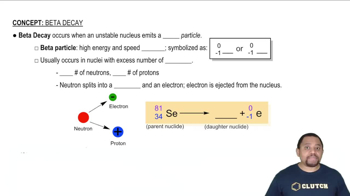Here are the essential concepts you must grasp in order to answer the question correctly.
Radiocarbon Dating
Radiocarbon dating is a method used to determine the age of organic materials by measuring the amount of carbon-14 (14C) remaining in a sample. 14C is a radioactive isotope of carbon that is formed in the atmosphere and taken up by living organisms. When an organism dies, it stops absorbing 14C, and the isotope begins to decay at a known rate, characterized by its half-life.
Half-Life
The half-life of a radioactive isotope is the time required for half of the isotope in a sample to decay. For 14C, the half-life is approximately 5715 years. This concept is crucial for calculating the age of an artifact, as it allows us to determine how many half-lives have passed since the organism's death based on the remaining activity of 14C in the sample.
Recommended video:
Exponential Decay
Exponential decay describes the process by which a quantity decreases at a rate proportional to its current value. In the context of radioactive decay, the activity of a radioactive substance decreases exponentially over time. The relationship can be expressed mathematically, allowing for the calculation of the age of an artifact by comparing its current activity to that of a standard reference.
Recommended video:




